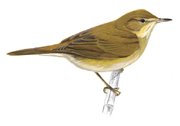138. Spotted Flycatcher
I have been very poor at writing my blog recently. I have just started a new job where I will be providing the food for a chain of seven cafes in Belfast, therefore alot of my time has been taken up setting up the kitchen.

Tonight I went for a walk with my wife in
Castle Ward (A National Trust estate nearby, where we lived for twelve years) It was a lovely evening and was made even better when within fifty yards of parking the car I saw the Spotted Flycatcher and its discreetly streaked breast. As I was watching through my binoculars my wife ,as usual, continued walking towards it and it flew off. These birds are on the Red List which means that they are Globally threatened, their Historical population declined in the UK during 1800-1995 and there has been
rapid (> or =50%) decline in UK breeding population over last 25 years and rapid (> or =50%) contraction of UK breeding range over last 25 years.

It is a summer visitor here and spends its winters in Africa. Now I know where to find it I will have to go back with my camera to see if I can get any shots.
Talking of Bird Photography I had a link from this blog to my list of bird photographers of the world which google has decided in its infinite wisdom is a spam site and have blocked me from posting to it or editing it so when I have the time I am going to set up a website dedicated to bird photography. I have registered the site www.peregrinesbirdphotographers.com and once my new job is more underway I will work on it. However for the time being I am adding the links to the side bar in this blog.
I have also been visiting a peregrines nest site, well I have been watching them across a quarry at
Scrabo Tower, two adults and four nearly fully fledged juveniles.

In this photo even though it is hard to make out there is the female and four chicks and the male was sitting on a rock 20 feet further up the quarry face. I have been to this site a number of times and what amazes me is the amount of woodpigeons that run the gauntlet of flying in front of the nest. You would have thought they would have the area designated as a no fly zone!
I am hoping for a call in the morning to say that a White Winged Tern that was spotted at RSPB Belfast Harbour Reserve this evening is still around and that I can go and see it before work tommorrow. It is a rare vagrant and there are 10-40 records annually in the UK and Ireland.The White-winged Tern, or White-winged Black Tern, Chlidonias leucopterus, is a small tern.
Adult birds in summer have short red legs and a short black bill, a black head, neck and belly, very dark grey back, with a white rump and light grey (almost white) tail. The wings, as the name implies, are mainly white. In non-breeding plumage, most of the black is replaced by white or pale grey.
Their breeding habitat is freshwater marshes across from southeast Europe to central Asia. They usually nest either on floating vegetation in a marsh or on the ground very close to water, laying 2-4 eggs in a nest built of small reed stems and other vegetation. In winter, they migrate to Africa, southern Asia and Australia. It is a scarce vagrant in North America, mainly on the Atlantic coast, but a few records on the Pacific coast and inland in the Great Lakes area.

Like the other "marsh" terns (Chlidonias), and unlike the "white" (Sterna) terns, these birds do not dive for fish, but fly slowly over the water to surface-pick items on the surface and catch insects in flight. They mainly eat insects and small fish.
The name 'White-winged Tern' is the standard in most English-speaking countries; in Britain, this name is also the one used by the formal ornithological recording authorities, but the older alternative 'White-winged Black Tern' is still frequent in popular use.
















